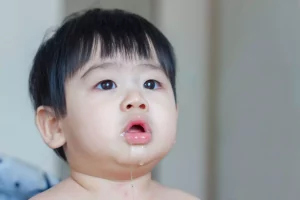By: Lori L. Overland MS, CCC-SLP,C/NDT,CLC, FOM
I am asked regularly by parents, therapists, physicians and participants who attend my courses how to address drooling. Copious drooling can be both a health and a social issue. I developed this webinar to explore the research on saliva production , and explore what is normal vs. abnormal drooling. This class focuses on assessment of the underlying issues that result in copious drooling and a therapeutic program to help address and mitigate this issue.
Drooling is defined as: “the unintentional loss of saliva from the mouth.”
Saliva production is essential to many functions including: lubricating your mouth, moistening food and assisting in breaking food down. Understanding typical saliva production is essential prior to assessment and treatment of what may be “atypical.”
Typical saliva production:
- increases at approximately three months of age
- decreases with upright positioning and motor development
- increases during teething stages
- levels may fluctuate up to two years of age
Long term, excessive or copious drooling is atypical and there are numerous potential causes. The list is long and may include:
- Developmental Issues
- Teething
- Airway Dysfunction (ex., mouth breathing, enlarged tonsils/adenoids)
- Oral Sensory Motor Delays/Disorders
- Structural Issues (ex., nasal blockage, tethered oral tissues),
- Neuromuscular/Sensory Dysfunction (ex., cerebral palsy, ALS, Parkinsons, stroke)
- Gastrointestinal Reflux
- Medications (ex., antipsychotics, tranquilizers, seizure medication)
- Infections (ex., rabies)
- Toxins (ex., mercury, pesticides)
- Gastrointestinal Reflux
- Allergies
- Syndromes (ex., Down syndrome, Rhetts syndrome, Familial Dysautonomia)
Assessment and treatment of drooling requires a team approach. It is critical to conduct a proper assessment to identify the etiology prior to considering treatment options. It is a RED FLAG when drooling starts at three months of age and persists.
Assessment
Here are a few things for a medical and therapeutic team to consider when assessing when drooling:
- Medical Issues
- Respiratory status
- Safety Issues
- Posture and alignment
- Sensory Issues
- Structural Issues
- Oral Motor Issues
- Social Issues
Treatment
Assessment will help to determine the most appropriate professional to lead the team and the most appropriate treatment options. Treatment often includes a combination of approaches that may involve multiple professionals, and interventions. These may include:
-
- Pharmacological
- Botox
- Surgical Treatment
- Vital Stim
- Therapy
Therapy
As therapists, we should be looking at the whole child, when evaluating and treating clients who have atypical drooling. The therapeutic intervention presented in this class focuses on:
- Supporting and facilitating posture and alignment
- Supporting sensory processing
- Facilitating oral sensory motor/skill development to support saliva control ( lip closure, check contraction, tongue retraction)
- Facilitating the motor skills for safe swallowing
Drooling can be a perfectly normal function, especially with young pediatric clients. But it is important to know the difference between typical drooling vs. atypical drooling. As members of a team we are called upon to provide assessment, consult with the family and team members, develop and implement therapeutic programs. If you are struggling with clients who drool copiously, this class can provide strategies for both assessment and treatment.
TalkTools Courses and Products related to Drooling:

